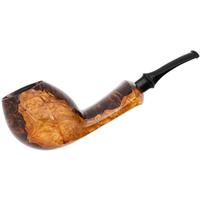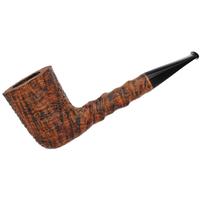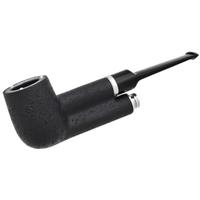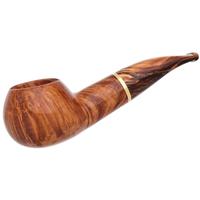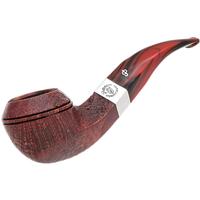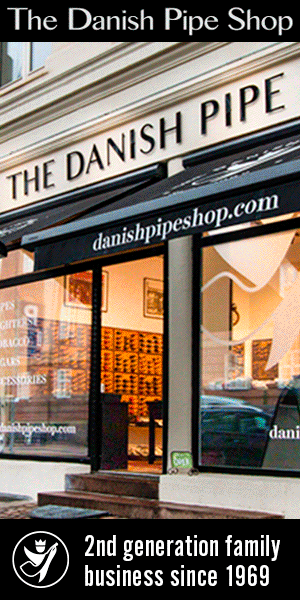School me on Aged Briar
- Thread starter Briar Lee
- Start date
You are using an out of date browser. It may not display this or other websites correctly.
You should upgrade or use an alternative browser.
You should upgrade or use an alternative browser.
- Status
- Not open for further replies.
If you believe that Algerian briars is the end all of the best briar, that makes it so for the believer. That does not make it so for everyone else. Obviously I have a decent collection of Marxman pipes. The are decent smokers. I can assure you they DO NOT out perform my Italian pipes such as Castello, Randice, Gepetto, or Kristiansen. For that matter neither do they out perform my Vauen, Stanwells, and Kaywoodies. BUT they do smoke better than a Lee.
High dollar pipes, of all luxury brands, are made of old, dense, good briar that’s fully cured and long seasoned, and if possible then aged.
The export product of Algeria before their civil war was likely on average the oldest and densest. But there’s nothing magical about it coming from Algeria.
Castello still advertises a ten year aging period for all their briar.
Every Marxman that Robert Marx made has now aged at least 70 years.
There had to have been variations in the Pre 54 Algerian export product.
My Tom Howard is huge, but light as a feather.
The value of a pre 54 Marxman is that it’s about the same as buying a bottled in bond bourbon.
There wasn’t any young, crappy Algerian briar for Marx to buy when he started in 1934. The French inspectors didn’t allow export of that kind.
Remember Mrs. Olson, who saved so many marriages of doe eyed young brides who made bad coffee?
The briar needs to be mountain grown,,,,:the richest kind.
Last edited:
Regardles, Van, the quality level of “the smoke” is a notable step below my better pipes. I think it’s “fair” to state that Marxman pipes give the owner a better than average mediocre smoke that is dependably better than mediocre. In a court of law this statement might meet the definition of factual. Anything more is supposition.High dollar pipes, of all luxury brands, are made of old, dense, good briar that’s fully cured and long seasoned, and if possible then aged.
The export product of Algeria before their civil war was likely on average the oldest and densest. But there’s nothing magical about it coming from Algeria.
Castello still advertises a ten year aging period for all their briar.
Every Marxman that Robert Marx made has now aged at least 70 years.
There had to have been variations in the Pre 54 Algerian export product.
My Tom Howard is huge, but light as a feather.
The value of a pre 54 Marxman is that it’s about the same as buying a bottled in bond bourbon.
There wasn’t any young, crappy Algerian briar for Marx to buy when he started in 1934. The French inspectors didn’t allow export of that kind.
Remember Mrs. Olson, who saved so many marriages of doe eyed young brides who made bad coffee?
The briar needs to be mountain grown,,,,:the richest kind.
A preponderance of the evidence is not supplying the jury with the same photo but only at different angles. Are you able to do a Lexus search on articles and supply case law regarding the superiority of Algerian Briar. Who else agrees with you? Do you have advertising that agrees with the point you are making? I live a good Marxman pipe as the next person but it seems to me opining what is provable detracts from what is positive about a Marxman. Namely, they are an interesting piece for a pipe collection and that Robert Marx was quite the pipe smoking character and salesman.
This is more like a poetry assignment than an evidentiary enquiry. We do not swear to tell the truth but rather to speak with passion.
I use that “The older the instrument, the sweeter the music” line at dollar draught night at the Legion.Woods are aged to make them stable. Less chance of cracking when done properly. Once you start smoking the pipe, chance are pretty good they won't age much longer. The fact is, the pores in the pipe chamber will be clogged with carbon and tars. And it basically stops breathing after awhile. So, really a dead wood. Fine musical instruments on the other hand, pore won't get plugged. As they are played, the wood will pick up the characters. Well kept old instruments are much more valuable than the new ones.
Don't know about "sweeter". I'm used to listening to open pipers playing 100+ year pipes. Those things in professional pipers will let loose banshees and make chill run down your spine. Amazing skills.I use that “The older the instrument, the sweeter the music” line at dollar draught night at the Legion.
I regard the upper crust who claim to have tasted tastes that I never get as advanced. As regards whether or not such tastes actually exist, I do not know. We cannot measure the accuracy of our palates by the standards of validity and reliability, which I have found to ascertain the existence of any phenomena. Validity: did we indeed measure what we thought we measured. Does your test indeed measure what you say it does? Reliability: do others get the same results? And then you dare publish at the risk of being eaten alive.I DO have pipes made from Algerian briar. Just not a Marxman.
Unfortunately that magical, transformative experience eludes me
Some of my pipes smoke hot. And some gurgle. Most smoke beautifully.
But taste-wise, I have yet to come across one that gives me a flavour other than the tobacco in it
Some of these pipes are 100year old NOS.
Perhaps at that age, any pixie dust in the chambers would have long given up their ghost
And then you enter the thicket of the palate where even practiced wine tasters don't agree.
If you say that you taste something, you do, but it seems to me that the palate is not subject to proof.
We’re having parallel conversations here.Don't know about "sweeter". I'm used to listening to open pipers playing 100+ year pipes. Those things in professional pipers will let loose banshees and make chill run down your spine. Amazing skills.
Super tasters do existI regard the upper crust who claim to have tasted tastes that I never get as advanced. As regards whether or not such tastes actually exist, I do not know. We cannot measure the accuracy of our palates by the standards of validity and reliability, which I have found to ascertain the existence of any phenomena. Validity: did we indeed measure what we thought we measured. Does your test indeed measure what you say it does? Reliability: do others get the same results? And then you dare publish at the risk of being eaten alive.
And then you enter the thicket of the palate where even practiced wine tasters don't agree.
If you say that you taste something, you do, but it seems to me that the palate is not subject to proof.
Even though I spent many a year “wine tasting”, I certainly do not belong to that group.
Taste is subjective, rather than objective.
As such, if someone tells me they taste cinnamon, I take their word for it.
Just that I do not experience that flavour or nuance
As an aside, I’m colour blind (red-green) - a common male genetic affliction.
My wife looks at me with incredulity because where she sees grey skies/clouds, I see pinks, magenta and purple.
Some years ago we were snorkelling in Fiji. Where she saw turd brown beche de mer, I saw beautiful vivid crimson creatures coruscating with fluorescent jewels
Aren’t our senses wonderful ?
Winston Churchill was the greatest man who ever spoke the English language.
And of course, Winnie kept his cigars with Dunhill. When Nazi bombs hit his shop Dunhill assured Winston his cigars were safe.
Of all the pipe makers who have ever lived, Alfred Dunhill was the most significant. None other, come even close.
It is to Alfred Dunhill’s accident we lovers of Algerian briar owe Dunhill a debt that we cannot repay.
Xxxx
The conception of sandblasting is reported in the book "About Smoke", released in mid-1920. Algeria had become an important source of briar, and Alfred Dunhill bought his first shipment in early 1914. Impressed with the beauty and richness of the grain of his new briar stock, he tried to put it into production but soon found that the results were not satisfactory on account of the softness of the material. Unused briar blocks were subsequently put aside and forgotten for months near the furnace. At random, sometime the next summer, he decided to re-examine these blocks and realized that some of the grains had shrunk, highlighting the grain and leaving a pattern of relief similar to that of a seashell--clearly the result of its prolonged exposure to Heat. The once voluminous wood was reduced to a mere shell of its former self, assuming a new and fascinating appearance while also becoming much lighter. These two factors combined create the perfect quality for both beautiful unique pieces and excellent smoking properties. The classic and iconic "Dunhill Shell Briar" is born!
 pipedia.org
pipedia.org
Xxxxx
Dunhill’s patent had not ran out in 1934 when a kid named Robert L Marx talked some old New York City bankers out of a lot of money to start a new pipe factory.
Marx carved his pipes, instead of blasting them.
He might have oil cured them, for all we know.
Not everyone likes the taste of pre 54 Algerian briar.
But if you do like it only that briar will do.
And of course, Winnie kept his cigars with Dunhill. When Nazi bombs hit his shop Dunhill assured Winston his cigars were safe.
Of all the pipe makers who have ever lived, Alfred Dunhill was the most significant. None other, come even close.
It is to Alfred Dunhill’s accident we lovers of Algerian briar owe Dunhill a debt that we cannot repay.
Xxxx
The conception of sandblasting is reported in the book "About Smoke", released in mid-1920. Algeria had become an important source of briar, and Alfred Dunhill bought his first shipment in early 1914. Impressed with the beauty and richness of the grain of his new briar stock, he tried to put it into production but soon found that the results were not satisfactory on account of the softness of the material. Unused briar blocks were subsequently put aside and forgotten for months near the furnace. At random, sometime the next summer, he decided to re-examine these blocks and realized that some of the grains had shrunk, highlighting the grain and leaving a pattern of relief similar to that of a seashell--clearly the result of its prolonged exposure to Heat. The once voluminous wood was reduced to a mere shell of its former self, assuming a new and fascinating appearance while also becoming much lighter. These two factors combined create the perfect quality for both beautiful unique pieces and excellent smoking properties. The classic and iconic "Dunhill Shell Briar" is born!
The History of Dunhill's Shell - Pipedia
Xxxxx
Dunhill’s patent had not ran out in 1934 when a kid named Robert L Marx talked some old New York City bankers out of a lot of money to start a new pipe factory.
Marx carved his pipes, instead of blasting them.
He might have oil cured them, for all we know.
Not everyone likes the taste of pre 54 Algerian briar.
But if you do like it only that briar will do.
Van. Who else other than you is over the moon crazy about Algerian Briar?Winston Churchill was the greatest man who ever spoke the English language.
And of course, Winnie kept his cigars with Dunhill. When Nazi bombs hit his shop Dunhill assured Winston his cigars were safe.
Of all the pipe makers who have ever lived, Alfred Dunhill was the most significant. None other, come even close.
It is to Alfred Dunhill’s accident we lovers of Algerian briar owe Dunhill a debt that we cannot repay.
Xxxx
The conception of sandblasting is reported in the book "About Smoke", released in mid-1920. Algeria had become an important source of briar, and Alfred Dunhill bought his first shipment in early 1914. Impressed with the beauty and richness of the grain of his new briar stock, he tried to put it into production but soon found that the results were not satisfactory on account of the softness of the material. Unused briar blocks were subsequently put aside and forgotten for months near the furnace. At random, sometime the next summer, he decided to re-examine these blocks and realized that some of the grains had shrunk, highlighting the grain and leaving a pattern of relief similar to that of a seashell--clearly the result of its prolonged exposure to Heat. The once voluminous wood was reduced to a mere shell of its former self, assuming a new and fascinating appearance while also becoming much lighter. These two factors combined create the perfect quality for both beautiful unique pieces and excellent smoking properties. The classic and iconic "Dunhill Shell Briar" is born!
The History of Dunhill's Shell - Pipedia
pipedia.org
Xxxxx
Dunhill’s patent had not ran out in 1934 when a kid named Robert L Marx talked some old New York City bankers out of a lot of money to start a new pipe factory.
Marx carved his pipes, instead of blasting them.
He might have oil cured them, for all we know.
Not everyone likes the taste of pre 54 Algerian briar.
But if you do like it only that briar will do.
Don’t you think by now more people would be chiming in and agreeing? It’s a fine enough briar but if it truly smoked better than other briars there would be some type of documentation by members of the pipe industry to back that statement up. Any way, I encourage you to get yourself a nice Castello or better yet, an oil cured Radice Rind. Let’s talk then. Besides, your driving up the prices of Marxmans.
Van. Who else other than you is over the moon crazy about Algerian Briar?
Don’t you think by now more people would be chiming in and agreeing? It’s a fine enough briar but if it truly smoked better than other briars there would be some type of documentation by members of the pipe industry to back that statement up. Any way, I encourage you to get yourself a nice Castello or better yet, an oil cured Radice Rind. Let’s talk then. Besides, your driving up the prices of Marxmans.
Here is perhaps the lowest quality briar pipe I own. Only the bowl is turned from Mediterranean briar on this Dr Grabow Viking. They could use the smallest burls, or get more burls from larger blocks.
View attachment 272913
The tobacco I’m smoking is the lowest grade of “pipe tobacco” sold.
It’s delicious. A great smoke.
Now, what was the best briar ever?
1934 Dunhill Shell
View attachment 272919
On a commercial basis it was that mountain grown Algerian briar so soft Alfred Dunhill had to patent a process to use it.
My old Algerian pipes are slightly better in about all ways you’d measure better except aesthetics.
And real asbestos is likely a little better than all modern substitutes as well.
Why don’t pipe makers try and resurrect the real coin, mountain grown, Algerian briar?
Mountain grown briar from Italy is mighty, mighty good.
The flame isn’t worth the candle.
Last edited:
Watch a top sommelier nose and taste a wine, and when he says "I think this is from California, it's a cabernet, I think in fact it's a north coast cabernet... and I think it's from Broken Oak and I'd guess the 2016." At the top level, they don't disagree and seldom get things wrong other than trivial details (this hillside vs that hillside).I regard the upper crust who claim to have tasted tastes that I never get as advanced. As regards whether or not such tastes actually exist, I do not know. We cannot measure the accuracy of our palates by the standards of validity and reliability, which I have found to ascertain the existence of any phenomena. Validity: did we indeed measure what we thought we measured. Does your test indeed measure what you say it does? Reliability: do others get the same results? And then you dare publish at the risk of being eaten alive.
And then you enter the thicket of the palate where even practiced wine tasters don't agree.
If you say that you taste something, you do, but it seems to me that the palate is not subject to proof.
When you blind taste stuff, you can't lie. You can only be.... well, wrong. You could guess Shiraz rather than Cabernet.
Carry this to pipes and it's a little more complicated because smoking technique plays a role and personal preferences come into play. But you can still de-mythologize pipes, talk about physics and chemistry rather than made-up history, talk about real-life experience rather than imagined scenarios and the consequences thereof.
To put it more crudely, you can fuck about and find out, as the kids say.
Watch a top sommelier nose and taste a wine, and when he says "I think this is from California, it's a cabernet, I think in fact it's a north coast cabernet... and I think it's from Broken Oak and I'd guess the 2016." At the top level, they don't disagree and seldom get things wrong other than trivial details (this hillside vs that hillside).
When you blind taste stuff, you can't lie. You can only be.... well, wrong. You could guess Shiraz rather than Cabernet.
Carry this to pipes and it's a little more complicated because smoking technique plays a role and personal preferences come into play. But you can still de-mythologize pipes, talk about physics and chemistry rather than made-up history, talk about real-life experience rather than imagined scenarios and the consequences thereof.
To put it more crudely, you can fuck about and find out, as the kids say.
One of my other passions is firearms, and I like shotguns the best.
The trouble with rifles, and to a lesser extent handguns, is they have military uses.
I own an old Swedish Mauser in 6.5 Swede and honestly, my son’s 6,5 Creedmor rifles are only marginally better, if any, than the Swedes developed in tests of military rifles in the 1890s.
Rifles are pure science. Every rifle is a compromise but since the 7mm Mauser there’s not been enough progress to really write about, except it’s hard to beat a 5.56 mm 62 grain bullet at just over 3,000 feet a second for the average, scared, very mortal soldier in a fire fight .
The same applies to a lesser degree to handguns. Shall we shoot a big, slow bullet or a faster, smaller bullet?
Shotguns are different. The military application of a shotgun is point blank range.
Like briar pipes, the scientists haven’t studied shotguns to perfection.
Most shotguns are used for pleasure.
I prefer knives. Chef's knife especially. I can gut and dress Butterball turkey faster than you can say "Algerian Briar" three times x) Of course, wild turkey is another story. I need to boil some water before cutting into it. Old trick from the street market in Seoul, Korea. You dip the fowl in a boiling water, the feathers come out much easier.One of my other passions is firearms, and I like shotguns the best.
The trouble with rifles, and to a lesser extent handguns, is they have military uses.
I own an old Swedish Mauser in 6.5 Swede and honestly, my son’s 6,5 Creedmor rifles are only marginally better, if any, than the Swedes developed in tests of military rifles in the 1890s.
Rifles are pure science. Every rifle is a compromise but since the 7mm Mauser there’s not been enough progress to really write about, except it’s hard to beat a 5.56 mm 62 grain bullet at just over 3,000 feet a second for the average, scared, very mortal soldier in a fire fight .
The same applies to a lesser degree to handguns. Shall we shoot a big, slow bullet or a faster, smaller bullet?
Shotguns are different. The military application of a shotgun is point blank range.
Like briar pipes, the scientists haven’t studied shotguns to perfection.
Most shotguns are used for pleasure.
I prefer knives. Chef's knife especially. I can gut and dress Butterball turkey faster than you can say "Algerian Briar" three times x) Of course, wild turkey is another story. I need to boil some water before cutting into it. Old trick from the street market in Seoul, Korea. You dip the fowl in a boiling water, the feathers come out much easier.
I also got really into knifes until I bought an Effingham Illinois made Blackjack Guide almost 30 years ago.
About the same time I bought a Case custom shop Vascomax knife and a couple of German made Case folders.
The top end best steel in a knife, is nice to have. But it’s really not all that very much better than 420 HC, which needs redone more often.
Razor sharp is razor sharp.
The same goes with mechanical watches.
My 1950 Hamilton 992 B is just an amazing gadget, as is my 1940 19 jewel solid gold Brock Hamilton wrist watch.
Every high grade Hamilton watch for the civilian market spent a year going through the factory, at least, being regulated to various positions, and temperatures, in various states of having the mainspring wound. They remain the highest quality controlled consumer products ever sold.
This one is about as good. And I can wear it it the shower, although I don’t.
View attachment 272938
And as for shotguns, the best American repeaters were the Ithaca Model 37s they made yesterday.
I own about a dozen Ithaca Model 37 shotguns and for a shotgun that i can use without any conscious thought about the gun, it becoming an extension of the will to shoot birds or targets, they are the equal of a London best gun that costs as much as a nice house.
But there aren’t any bad, new shotguns any more.
My Benelli Montefeltro is more than good enough.
Last edited:
You've convinced me, I'm going to make it my business to get a pre-1954 Algerian briar. One will pop up on e-bay eventually. Why do they all have that grissled and gnarled exterior? Could that not have been chiseled down and sanded?
Here is a seventies Preben Holm, a beautiful straight grain with a matte finish. It has a huge bore, and was hand made from a large burl of something other than Pre 54 Algerian briar. It has very thick walls.
View attachment 272994
It tastes great, is a good smoker, and gets hotter than a two dollar pistol if you don’t sip it extremely slow. Even then it gets hot, and sweats. I could burn this out or toast the briar easily.
View attachment 272996
Never say never, but I’ve never had a Marxman of any size get hot, and the bigger they are the cooler they smoke.
But old Algerian briar is soft, it’s seldom beautiful, it was hard to work with, and one good reason it was used was because it has amazing insulating qualities. I think it has a peppery cinnamon taste, but it definitely was almost fire proof and they smoke like little thermos jugs.
Just don’t expect a pretty pipe.
1934 Dunhill with typical reddish brown patina.
View attachment 272999
Last edited:
- Status
- Not open for further replies.



